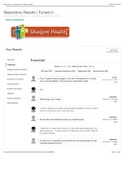Summary
Summary Interaction Design, ISBN: 9781119547358 INF3720 - Human-Computer Interaction II (INF3720)
- Course
- Institution
- Book
Summary of all prescribed chapters for INF3720 - Human Computer Interaction II. Textbook: Interaction Design 5th edition. Headings and figures with page references to the textbook.
[Show more]












